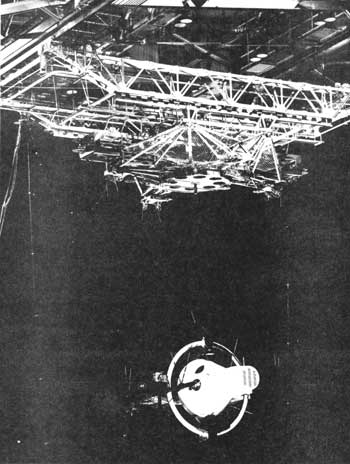.gif)
|
Man in Space
A National Historic Landmark Theme Study |

|
|
Apollo Training Facilities |

Rendezvous Docking Simulator with Gemini module, 1964.
(Courtesy of NASA, NASA/Langley Archives Office)
Rendezvous Docking Simulator
| Name: | Rendezvous Docking Simulator (Real-Time Dynamic Simulator) |
| Location: | Langley Research Center, Hampton, Virginia |
| Owner: | National Aeronautics and Space Administration (NASA) |
| Condition: | Excellent, altered, original site |
| Builder/Architect: | NASA |
| Dates: | 1963-1972 |
DESCRIPTION
The Rendezvous Docking Simulator (RDS) is in Building 1244 in the East Area of the Langley Research Center. The RDS is a full-scale dynamic facility which was used to study pilot-controlled docking of various types of space vehicles. It was built in 1963 and simulated controlled docking procedures for both the Gemini spacecraft with the Agena booster and the Apollo Lunar Excursion Module with the Command Module.
The simulator consists of an overhead carriage and cable-suspended gimbal system. The carriage is electrically driven and provides three degrees of freedom in translation. The gimbal is hydraulically driven and provides three degrees of freedom in rotation. Thus, the pilot flies the vehicle in six-degree-of-freedom motion which is controlled in a closed-loop fashion through a ground-based analog computer. The operating volume of the simulator is 210 feet horizontally by 15 feet laterally and 40 feet vertically. This enabled the test pilots to dock with target Gemini and Apollo spacecraft in a three dimensional mode. [1] Depending upon the test, either a full scale module of the Gemini or Apollo spacecraft, could be hung from the simulator.
After the completion of the Apollo program the Rendezvous Docking Simulator was modified to solve open-and-closed loop pilot control problems, aircraft landing approaches, simulator validation studies, and passenger ride quality studies. The name of the facility was changed and it is now called the Real-Time Dynamic Simulator. Modifications to the facility consisted of removing the Apollo Command Module cockpit and installing an aircraft cockpit. The system was also linked to the Langley real-time digital computer system and Langley landing terrain scene generator. [2] At the present time this facility is no longer in use.
STATEMENT OF SIGNIFICANCE
The Rendezvous Docking Simulator is significant because it permitted NASA to train Gemini and Apollo astronauts in docking procedures they had to master before attempting to land on the moon. The simulator gave the astronauts the experience of a docking spacecraft in a safe three dimensional mode that closely approximated a space environment. Training received here and in the Lunar Landing Research Facility was indispensable to accomplishing the goal of landing men on the moon by 1969.
The decision by President Kennedy to land a man on the moon by 1969 meant that NASA had to quickly decide the method of accomplishing the journey. NASA engineers decided that the best method of accomplishing the goal of the moon landing was through the concept of the lunar orbit rendezvous (LOR) which called for a single Saturn V launch of two spacecraft into lunar orbit where one would remain in orbit and the other would descend to the moon. Successful completion of this method of traveling to the moon meant that the vehicle on the moon would have to boost itself back into lunar orbit, rendezvous, and dock with the mother ship and then return to the Earth.
The LOR technique was a bold decision to speed up the schedule for landing a man on the moon. To accomplish this mission it was essential that Apollo astronauts be trained in all aspects and problems likely to arise in the attempt to dock the Apollo Command and Lunar Excursion Modules in lunar orbit. Failure to accomplish this docking would result in the failure of the entire mission and the likely loss of the lives of the astronauts. This justified the need for the Rendezvous Docking Simulator. Only when the Apollo astronauts had successfully mastered rendezvous and docking skills, learned on this facility, would NASA give permission for the attempt to land on the moon.
FOOTNOTES
1. Howard G. Hatch, Jr., Jack E. Pennington, and Jere B. Cobb, Dynamic Simulation of Lunar Module Docking with Apollo Module in Lunar Orbit NASA TN D-3972 (Hampton, Va: Langley Research Center, No Date), p. 3.
2. Technical Facilities Catalog Vol. I. (Washington, D.C.: National Aeronautics and Space Administration, 1974), pp. 3-44, 3-45.
BIBLIOGRAPHY
Benson, Charles D., and Faherty, William Barnaby. Moonport: A History of Apollo Launch Facilities and Operations. Washington D.C.: National Aeronautics and Space Administration, 1979.
Brooks, Courtney G., Grimwood, James, and Swenson, Jr., Loyd S. Chariots for Apollo: A History of Manned Lunar Spacecraft. Washington, D.C.: National Aeronautics and Space Administration, 1979.
Hatch, Howard C., Pennington, Jack E., and Cobb, Jere B. Dynamic Simulation of Lunar Module Docking with Apollo Command Module in Lunar Orbit. NASA TN D-3972. Hampton, Va.: Langley Research Center, No Date Given.
Langley Research Center Staff. A Compilation of Recent Research Related to the Apollo Mission. TM X-890. Hampton, Va.: Langley Research Center, No Date Given.
Levine, Arnold S. Managing NASA in the Apollo Era. Washington, D.C.: National Aeronautics and Space Administration, 1982.
Long, Edward R., Pennington, Jack E., and Deal, Perry L. Remote Pilot-Controlled Docking with Television. NASA TN D-3044. Hampton, Va.: Langley Research Center, No Date Given.
Pennington, Jack E., Hatch, Howard, Jr., G., and Driscoll, Norman R. A Full-Size Pilot-Controlled Docking Simulation of the Apollo Command and Service Module with the Lunar Module. NASA TN D-3688. Hampton, Va.: Langley Research Center, 1966.
Technical Facilities Catalog Vol. I. National Aeronautics and Space Administration, 1974.
U.S. Congress. House, United States Civilian Space Programs A Report prepared for the Subcommittee on Space Science and Applications. Serial D, Vol. 1, January 1981.
PHOTOGRAPHS
(click on the above photographs for a more detailed view)
Last Modified: Mon, Jan 8 2001 10:00:00 am PDT
man-in-space/space15.htm





 Top
Top